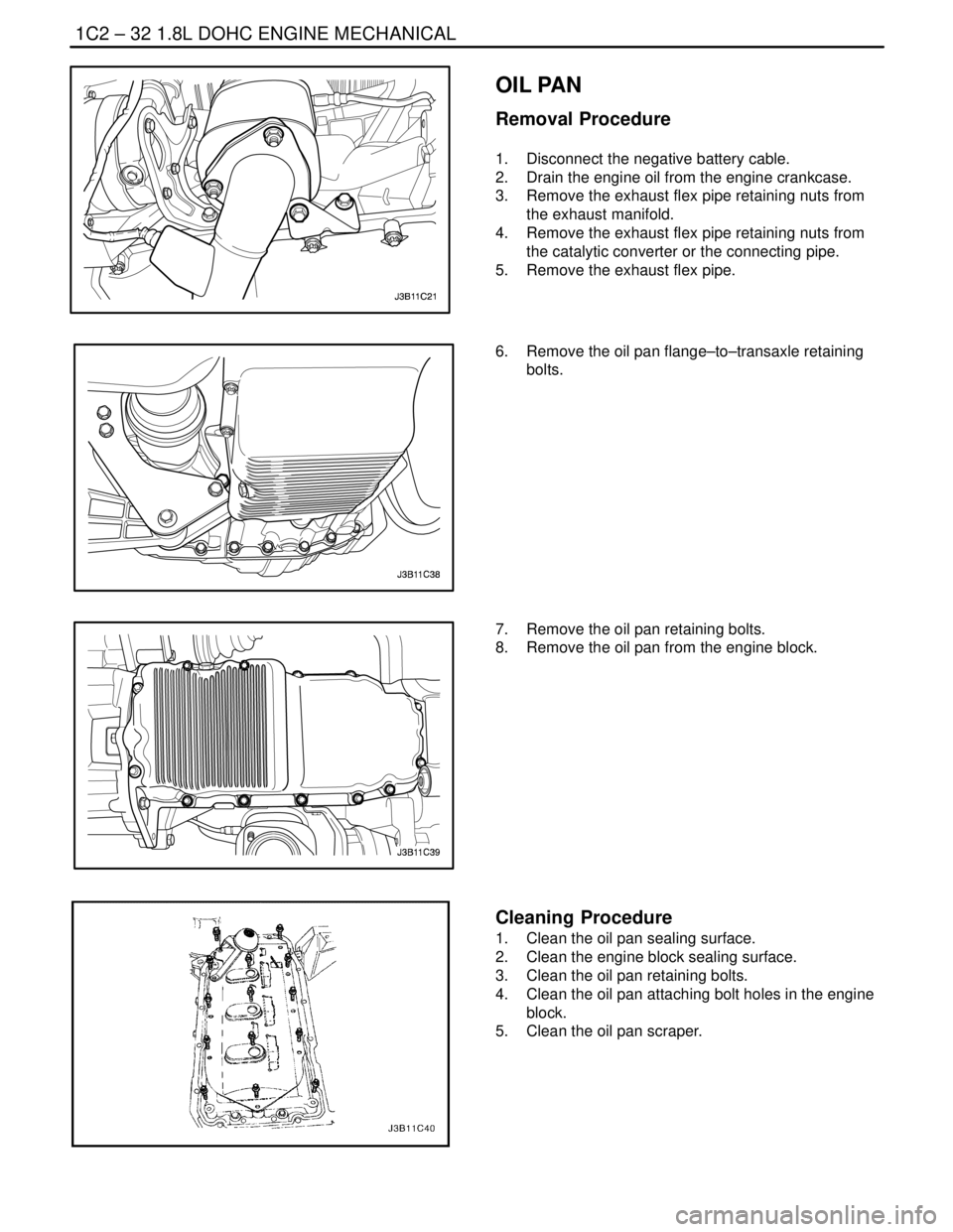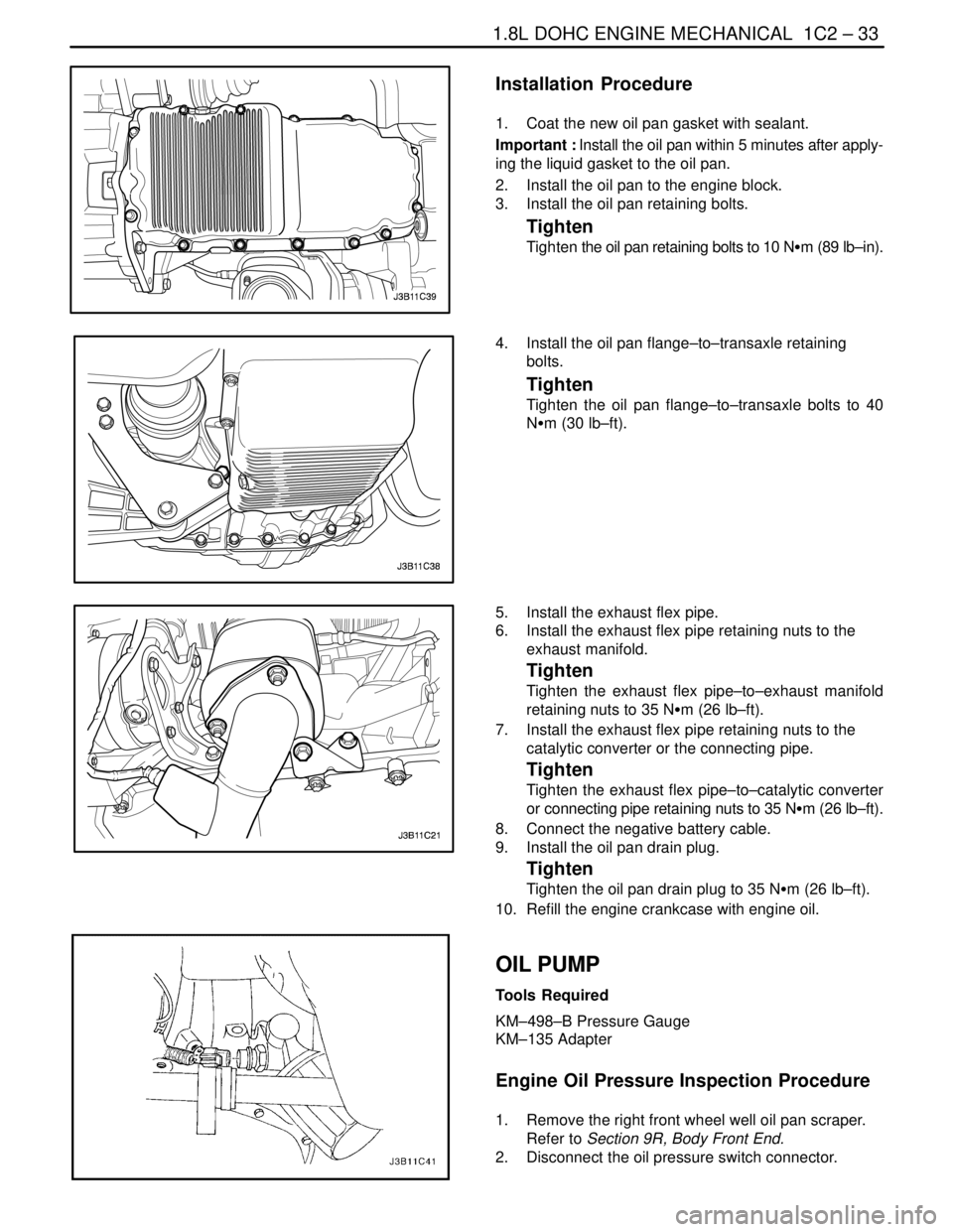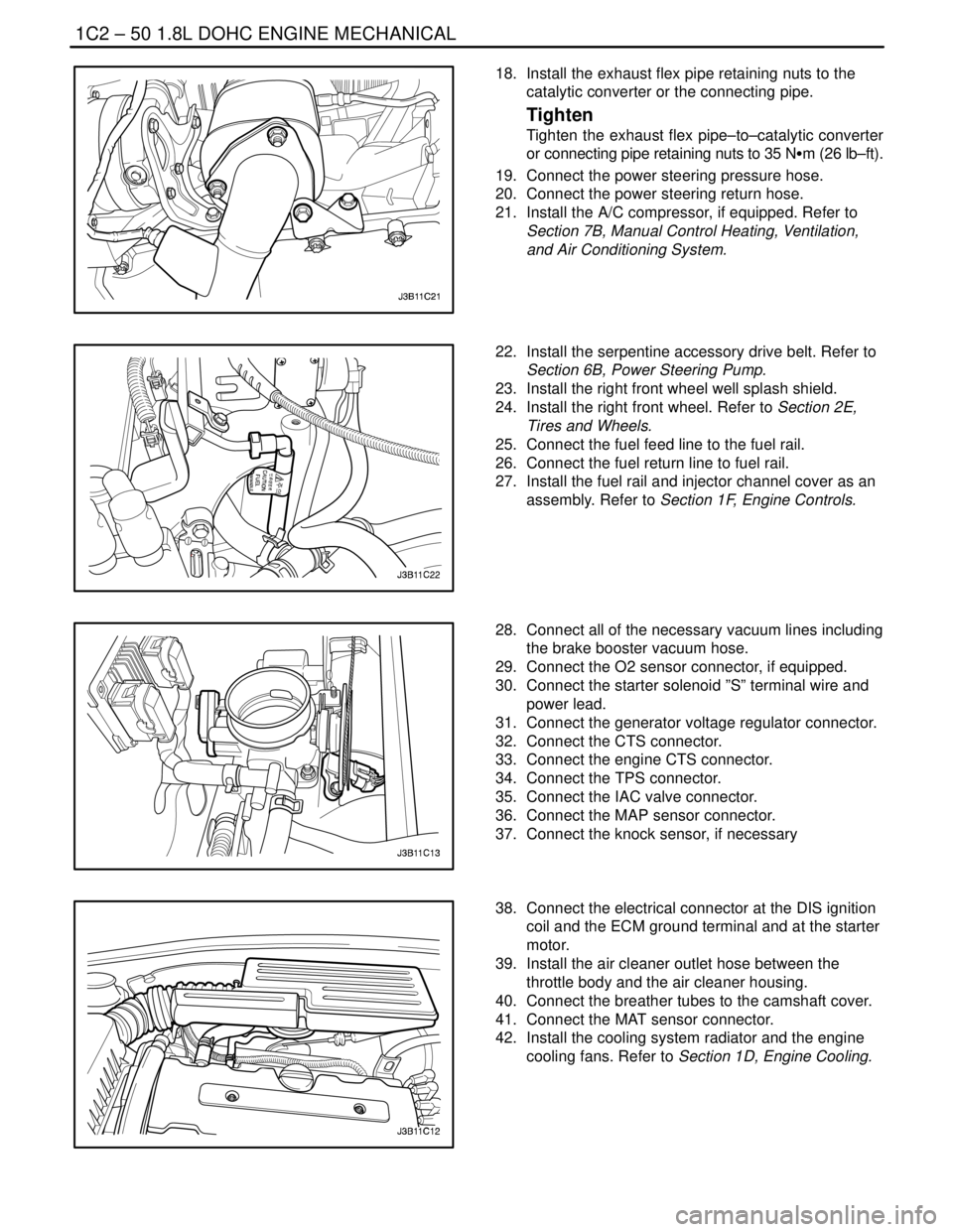2004 DAEWOO LACETTI catalytic converter
[x] Cancel search: catalytic converterPage 152 of 2643

1C2 – 32I1.8L DOHC ENGINE MECHANICAL
DAEWOO V–121 BL4
OIL PAN
Removal Procedure
1. Disconnect the negative battery cable.
2. Drain the engine oil from the engine crankcase.
3. Remove the exhaust flex pipe retaining nuts from
the exhaust manifold.
4. Remove the exhaust flex pipe retaining nuts from
the catalytic converter or the connecting pipe.
5. Remove the exhaust flex pipe.
6. Remove the oil pan flange–to–transaxle retaining
bolts.
7. Remove the oil pan retaining bolts.
8. Remove the oil pan from the engine block.
Cleaning Procedure
1. Clean the oil pan sealing surface.
2. Clean the engine block sealing surface.
3. Clean the oil pan retaining bolts.
4. Clean the oil pan attaching bolt holes in the engine
block.
5. Clean the oil pan scraper.
Page 153 of 2643

1.8L DOHC ENGINE MECHANICAL 1C2 – 33
DAEWOO V–121 BL4
Installation Procedure
1. Coat the new oil pan gasket with sealant.
Important : Install the oil pan within 5 minutes after apply-
ing the liquid gasket to the oil pan.
2. Install the oil pan to the engine block.
3. Install the oil pan retaining bolts.
Tighten
Tighten the oil pan retaining bolts to 10 NSm (89 lb–in).
4. Install the oil pan flange–to–transaxle retaining
bolts.
Tighten
Tighten the oil pan flange–to–transaxle bolts to 40
NSm (30 lb–ft).
5. Install the exhaust flex pipe.
6. Install the exhaust flex pipe retaining nuts to the
exhaust manifold.
Tighten
Tighten the exhaust flex pipe–to–exhaust manifold
retaining nuts to 35 NSm (26 lb–ft).
7. Install the exhaust flex pipe retaining nuts to the
catalytic converter or the connecting pipe.
Tighten
Tighten the exhaust flex pipe–to–catalytic converter
or connecting pipe retaining nuts to 35 NSm (26 lb–ft).
8. Connect the negative battery cable.
9. Install the oil pan drain plug.
Tighten
Tighten the oil pan drain plug to 35 NSm (26 lb–ft).
10. Refill the engine crankcase with engine oil.
OIL PUMP
Tools Required
KM–498–B Pressure Gauge
KM–135 Adapter
Engine Oil Pressure Inspection Procedure
1. Remove the right front wheel well oil pan scraper.
Refer to Section 9R, Body Front End.
2. Disconnect the oil pressure switch connector.
Page 167 of 2643

1.8L DOHC ENGINE MECHANICAL 1C2 – 47
DAEWOO V–121 BL4
19. Disconnect the oxygen (O2) sensor connector, if
equipped.
20. Disconnect the idle air control (IAC) valve connec-
tor.
21. Disconnect the throttle position sensor (TPS) con-
nector.
22. Disconnect the engine coolant temperature sensor
(CTS) connector.
23. Disconnect the CTS connector.
24. Disconnect the generator voltage regulator connec-
tor and power lead.
25. Disconnect all of the necessary vacuum lines, in-
cluding the brake booster vacuum hose.
26. Disconnect the fuel return line at the fuel rail.
27. Disconnect the fuel feed line at the fuel rail.
28. Remove the fuel rail and injector channel cover as
an assembly. Refer to Section 1F, Engine Controls.
29. Disconnect the throttle cable from the throttle body
and the intake manifold bracket.
30. Disconnect the coolant hose at the throttle body.
31. Disconnect the heater outlet hose at the coolant
pipe.
32. Disconnect the coolant bypass hose from the cylin-
der head.
33. Disconnect the surge tank coolant hose from the
coolant pipe.
34. Disconnect the lower radiator hose from the coolant
pipe.
35. Disconnect the starter solenoid ”S” terminal wire
and power lead.
36. Remove the A/C compressor. Refer to Section 7B,
Manual Control Heating, Ventilation, and Air Condi-
tioning Systems.
37. Remove the exhaust flex pipe retaining nuts from
the exhaust manifold studs.
38. Remove the exhaust flex pipe retaining nuts from
the catalytic converter or the connecting pipe.
39. Remove the exhaust flex pipe.
Page 170 of 2643

1C2 – 50I1.8L DOHC ENGINE MECHANICAL
DAEWOO V–121 BL4
18. Install the exhaust flex pipe retaining nuts to the
catalytic converter or the connecting pipe.
Tighten
Tighten the exhaust flex pipe–to–catalytic converter
or connecting pipe retaining nuts to 35 NSm (26 lb–ft).
19. Connect the power steering pressure hose.
20. Connect the power steering return hose.
21. Install the A/C compressor, if equipped. Refer to
Section 7B, Manual Control Heating, Ventilation,
and Air Conditioning System.
22. Install the serpentine accessory drive belt. Refer to
Section 6B, Power Steering Pump.
23. Install the right front wheel well splash shield.
24. Install the right front wheel. Refer to Section 2E,
Tires and Wheels.
25. Connect the fuel feed line to the fuel rail.
26. Connect the fuel return line to fuel rail.
27. Install the fuel rail and injector channel cover as an
assembly. Refer to Section 1F, Engine Controls.
28. Connect all of the necessary vacuum lines including
the brake booster vacuum hose.
29. Connect the O2 sensor connector, if equipped.
30. Connect the starter solenoid ”S” terminal wire and
power lead.
31. Connect the generator voltage regulator connector.
32. Connect the CTS connector.
33. Connect the engine CTS connector.
34. Connect the TPS connector.
35. Connect the IAC valve connector.
36. Connect the MAP sensor connector.
37. Connect the knock sensor, if necessary
38. Connect the electrical connector at the DIS ignition
coil and the ECM ground terminal and at the starter
motor.
39. Install the air cleaner outlet hose between the
throttle body and the air cleaner housing.
40. Connect the breather tubes to the camshaft cover.
41. Connect the MAT sensor connector.
42. Install the cooling system radiator and the engine
cooling fans. Refer to Section 1D, Engine Cooling.
Page 254 of 2643

1F – 8IENGINE CONTROLS
DAEWOO V–121 BL4
EGR Desired Position
The desired exhaust gas recirculation (EGR) position is
the commanded EGR position. The ECM calculates the
desired EGR position. The higher the percentage, the lon-
ger the ECM is commanding the EGR valve ON.
Engine Load
Indicates engine load based on manifold absolute pres-
sure. The higher the percentage, the more load the engine
is under.
Engine Run Time
The engine run time is a measure of how long the engine
has been running. When the engine stops running, the tim-
er resets to zero.
Engine Speed
Engine Speed is computed by the ECM from the fuel con-
trol reference input. It should remain close to desired idle
under the various engine loads with the engine idling.
Fan
The Fan Control (FC) Relay is commanded by the ECM.
The FC Relay displays the command as ON or OFF.
Fuel Level Sensor
The Fuel Level Sensor monitors the fuel level in the tank.
The Fuel Level Sensor monitors the rate of change of the
air pressure in the EVAP system. Several of the Enhanced
EVAP System diagnostics are dependent upon the correct
fuel level.
Fuel System Status
The Closed Loop is displayed indicating that the ECM is
controlling the fuel delivery according to the Front Heated
Oxygen Sensor (HO2S1) voltage as close to an air/fuel ra-
tio of 14.7 to 1 as possible.
IAC Position
The scan tool displays the ECM command for the Idle Air
Control (IAC) pintle position in counts. The higher the
number of counts, the greater the commanded idle speed
reads. The Idle Air Control responds to changes in the en-
gine load in order to maintain the desired idle rpm.
Ignition 1 (Voltage)
The ignition volts represent the system voltage measured
by the ECM at the ignition feed circuit.
Intake Air Temperature
The ECM converts the resistance of the Intake Air Tem-
perature (IAT) sensor to degrees in the same manner as
the engine coolant temperature (ECT) sensor. In take air
temperature is used by the ECM to adjust fuel delivery and
spark timing according to incoming air density.Knock Present
The KS Noise Channel indicates when the ECM detects
the KS signal. The ECM should display NO at idle.
Long Term FT
The Long Term Fuel Trim (FT) is derived from the short
term fuel trim value. The Long Term FT is used for the long
term correction of the fuel delivery. A value of 128 counts
(0%) indicates that the fuel delivery requires no com-
pensation in order to maintain a 14.7:1 air to fuel ratio. A
value below 128 counts means that the fuel system is too
rich and the fuel delivery is being reduced. The ECM is de-
creasing the injector pulse width. A value above 128
counts indicates that a lean condition exists for which the
ECM is compensating.
MAP
The Manifold Absolute Pressure (MAP) sensor measures
the change in the intake manifold pressure which results
from engine load and speed changes. As the intake man-
ifold pressure increases, the air density in the intake also
increases and the additional fuel is required.
Misfire History #1–4
Indicates the number of misfires that have occurred after
195 current misfires have been counted. The current mis-
fire counter will add its misfires to the history misfire count-
er after 195 total misfires have taken place. If 1 cylinder is
misfiring, the misfiring current counter will have 195 mis-
fires counted before adding to its history counter. If 2 cylin-
ders are misfiring, the misfiring current counter will add to
their history counters after 97 misfires. The counter incre-
ments only after a misfire diagnostic trouble code (DTC)
has been set.
Front Heated Oxygen Sensor
The pre–converter Front Heated Oxygen Sensor
(HO2S1) reading represents the exhaust oxygen sensor
output voltage. This voltage will fluctuate constantly be-
tween 100 mv (lean exhaust) and 900 mv (rich exhaust)
when the system is operating in a Closed Loop.
Rear Heated Oxygen Sensor
The post–converter Rear Heated Oxygen Sensor
(HO2S2) represents the exhaust oxygen output voltage
past the catalytic converter. This voltage remains inactive,
or the voltage will appear lazy within a range of 100 mv
(lean exhaust) and 900 mv (rich exhaust) when operating
in a Closed Loop.
Short Term FT
The Short Term FT represents a short term correction to
fuel delivery by the ECM in response to the amount of time
the oxygen sensor voltage spends above or below the 450
mv threshold. If the oxygen sensor has mainly been below
450 mv, indicating a lean air/fuel mixture, short term fuel
trim will increase to tell the ECM to add fuel. If the oxygen
sensor voltage stays mainly above the threshold, the ECM
will reduce fuel delivery to compensate for the indicated
rich condition.
Page 476 of 2643

1F – 230IENGINE CONTROLS
DAEWOO V–121 BL4
DIAGNOSTIC TROUBLE CODE (DTC) P0420
CATALYST LOW EFFICIENCY
Circuit Description
In order to control exhaust emissions of Hydrocarbons
(HC), Carbon Monoxide (CO) and Nitrogen Oxide (NOx),
a Three–Way Catalytic Converter (TWC) is used. The cat-
alyst within the converter promotes a chemical reaction
which oxidizes the HC and CO present in the exhaust gas,
converting them into harmless water vapor and carbon
dioxide, it also reduces NOx, converting it into nitrogen.
The catalytic converter also has the ability to store oxygen.
The Engine Control Module (ECM) has the capability to
monitor this process using a Heated Oxygen Sensor
(HO2S) located in the exhaust stream past the TWC. The
HO2S produces an output signal which indicates the oxy-
gen storage capacity of the catalyst; this in turn indicates
the catalyst’s ability to convert exhaust emissions effec-
tively. The ECM monitors the catalyst efficiency by first al-
lowing the catalyst to heat up, waiting for a stabilization pe-
riod while the engine is idling, and then adding and
removing fuel while monitoring the reaction of the HO2S.
When the catalyst is functioning properly, the HO2S re-
sponse to the extra fuel is slow compared to the Oxygen
Sensor (O2S). When the HO2S response is close to that
of the O2S, the Oxygen storage capability or efficiency of
the catalyst is considered to be bad, and the Malfunction
Indicator Lamp (MIL) will illuminate.
Conditions for Setting the DTC
S Closed loop stoichiometry.
S Engine Coolant Temperature (ECT) is more than
75°C (167°F) . (1.4L DOHC)
S Engine Coolant Temperature (ECT) is more than
70°C (158°F) . (1.6L DOHC)
S Engine speed between 1,766rpm and 2,368rpm.
(1.4L DOHC)
S Engine speed between 1,760rpm and 2,530rpm.
(1.6L DOHC)
S Vehicle speed is between 47km/h (29.2mph) and
80km/h (49.7mph). (1.4L DOHC)
S Vehicle speed is between 60km/h (37.3mph) and
76km/h (47.2mph). (1.6L DOHC)
S The manifold absolute pressure is greater than 70
kpa. (1.4L DOHC)S The manifold absolute pressure is greater than 76
kpa. (1.6L DOHC)
S Activity of the heated oxygen sensor excited by
lambda controller stimuli higher than a threshold.
S DTC(s) P0107, P0108, P0117, P0118, P0122,
P0123, P0131, P0132, P0133, P0137, P0138,
P0140, P0141, P0171, P0172, P0300, P0336,
P0337, P0341, P0342, P0351, P0352, P0404,
P0405, P0405 and P0562 are not sets.
Action Taken When the DTC Sets
S The Malfunction Indicator Lamp (MIL) will illuminate
after three consecutive trip with a fail.
S The ECM will record operating conditions at the
time the diagnostic fail. This information will be
stored in the Freeze Frame and Failure Records
buffers.
S A history DTC is stored.
Conditions for Clearing the MIL/DTC
S The MIL will turn off after four consecutive ignition
cycles in which the diagnostic runs without a fault.
S A history DTC will clear after 40 consecutive warm–
up cycles without a fault.
S DTC(s) can be cleared by using the scan tool.
S Disconnecting the ECM battery feed for more than
10 seconds.
Diagnostic Aids
The catalyst test may abort due to a change in the engine
load. Do not change the engine load (i.e. A/C, coolant fan,
heater motor) while a catalyst test is in progress.
An intermittent problem may be caused by a poor connec-
tion, rubbed–through wire insulation, or a wire that is bro-
ken inside the insulation.
Any circuitry, that is suspected as causing the intermittent
complaint, should be thoroughly checked for the following
conditions:
S Backed–out terminals
S Improper mating
S Broken locks
S Improperly formed
S Damaged terminals
S Poor terminal–to–wire connection.
Page 477 of 2643

ENGINE CONTROLS 1F – 231
DAEWOO V–121 BL4
DTC P0420 – Catalyst Low Efficiency
StepActionValue(s)YesNo
1Perform an Euro On–Board Diagnostic (EOBD)
System Check.
Was the check performed?–Go to Step 2Go to
”On–Board
Diagnostic Sys-
tem Check”
21. Install a scan tool to the Data link Connector
(DLC).
2. Turn the ignition ON.
Are any component Diagnostic Trouble Codes
(DTCs) set?–Go to
Applicable DTC
tableGo to Step 3
31. Visually/physically check the following:
2. Exhaust system for a leak.
3. Heated Oxygen Sensor (HO2S).
Is a problem found?–Go to Step 4Go to Step 5
4Repair the exhaust system as needed.
Is the repair complete?–Go to Step 6–
5Replace the Three Way Catalytic Converter (TWC).
Is the repair complete?–Go to Step 6–
61. Using the scan tool, clear the Diagnostic
Trouble Codes (DTCs).
2. Start the engine and idle at normal operating
temperature.
3. Operate the vehicle within the Conditions for
setting this DTC as specified in the supporting
text.
Does the scan tool indicate that this diagnostic has
run and passed?–Go to Step 7Go to Step 2
7Check if any additional DTCs are set.
Are any DTCs displayed that have not been diag-
nosed?–Go to
Applicable DTC
tableSystem OK
Page 626 of 2643

1F – 380IENGINE CONTROLS
DAEWOO V–121 BL4
StepNo Yes Value(s) Action
4Did the scan tool indicate that DTC P1133 or P1134
failed this ignition cycle.–Go to
”Applicable
DTC table”Go to Step 5
5Check the exhaust manifold/catalytic converter for
a leak and repair as needed.
Is the repair complete?–Go to Step 16Go to Step 6
6Visually/physically inspect for the following items:
S Front Heated Oxygen Sensor (HO2S1) is se-
curely installed.
S Corrosion on the terminals.
S Terminal tension.
S HO2S1 wiring harness for poor terminal con-
nection or damaged wiring.
Is a problem found in any of the above areas?–Go to Step 9Go to Step 7
71. Turn the ignition OFF.
2. Disconnect the HO2S1 connector.
3. Jumper the HO2S1 low circuit, terminal 3 to
ground.
4. Turn the ignition ON.
Does the scan tool indicate the voltage between the
specified value?400 – 500 mVGo to Step 8Go to Step 10
8Jumper the HO2S1 signal and low circuit terminal 4
to ground.
Does the scan tool indicate the voltage below the
specified value?200 mVGo to Step 15Go to Step 13
9Repair the condition as necessary.
Is the repair complete?–Go to Step 16–
10S Turn the ignition OFF.
S Disconnect the ECM connector.
S Check the HO2S1 low circuit for an open or
poor connection and repair as needed.
Is the repair complete?–Go to Step 16Go to Step 11
11Check the terminal M29 of the ECM for poor connec-
tion and repair as needed.
Is the repair complete?–Go to Step 16Go to Step 14
12Check the HO2S1 signal circuit for an open or short
to ground and repair as needed.
Is the repair complete?–Go to Step 16Go to Step 13
13Check the terminal M12 of the ECM for poor connec-
tion and repair as needed.
Is the repair complete?–Go to Step 16Go to Step 14
14S Turn the ignition OFF.
S Replace the ECM.
Is the repair complete?–Go to Step 16–
15Replace the HO2S1.
Is the repair complete?–Go to Step 16–